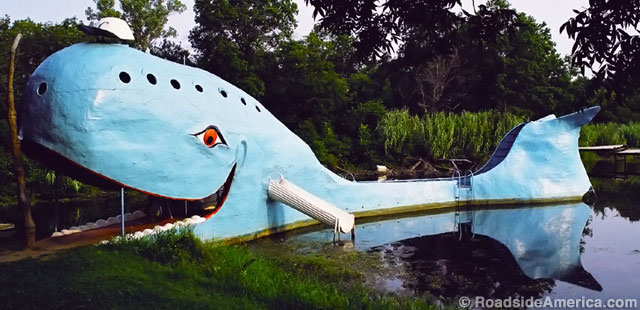
The whale's most visible eye is wide-awake, facing the sunrise. The other is sleepy, facing the sunset.
The Blue Whale
Catoosa, Oklahoma
Before there was the Blue Whale, there was Nature's Acres. It was a Route 66 animal attraction with a replica Noah's Ark, alligators that roamed free, and a pit of poisonous snakes (This was a simpler time). The owners were Hugh and Zelta Davis.
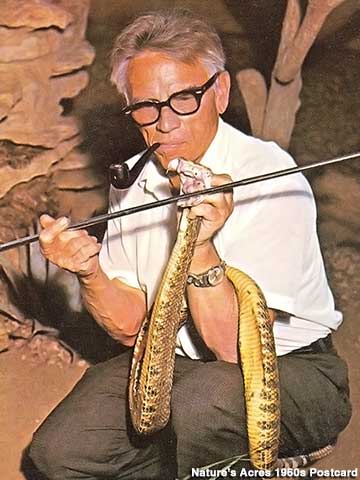
Hugh Davis "milked" poisonous snakes for their venom.
Hugh's first wife had died of "lung trouble," age 26, after joining Hugh on one of his exotic animal-gathering safaris. Zelta was built of stronger stuff. A widow when she was only 16 (she saw her first husband crushed by a truck), Zelta would often wrap her body in live snakes during wildlife shows with Hugh. She was nearly killed when an alligator named Big Betty grabbed her hand and dragged her into a Nature's Acres pond (Zelta escaped by banging on its nose). She saved Hugh's life at least once by knifing open his arm and bleeding out the poison when he was bitten during a snake-milking demonstration.
Hugh and Zelta eventually grew tired of cheating death, and retired from the gator-and-snake business. Hugh needed something to do, so he decided to build a gift for Zelta. He wanted to celebrate her love of animals, so he decided to give her the biggest one that he could think of: a whale.
Hugh (and a welder named Harold Thomas) spent two years building the giant marine mammal out of a steel rod and pipe, covered in plaster and concrete. Eighty feet long, beached on the shore of one of Nature's Acres old gator ponds, the whale invited exploration with a wide-open mouth, portholes in its head, water slides instead of fins, and a diving platform on its tail. Hugh officially presented it to Zelta on September 7, 1972, the Davis's 34th wedding anniversary. Zelta later recalled that Hugh had considered painting the whale black-and-white like a Killer Whale, but she vetoed the idea. "We don't have mean things," she said, and so the whale became the friendly Blue Whale.
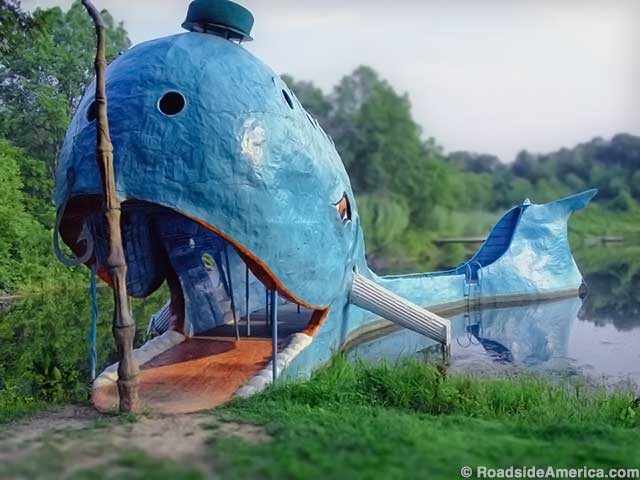
Route 66 pilgrims eagerly anticipate being swallowed by this whale.
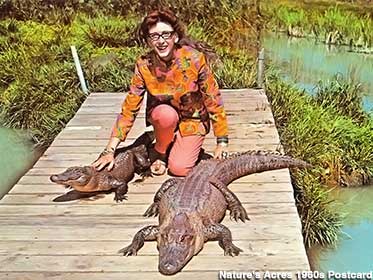
Zelta Davis and her alligators. One almost ate her.
Hugh and Zelta viewed the project as a private whale, to be used only by their grandchildren. But its location along the Mother Road drew curious visitors, and eventually the Davises opened it as a public attraction.
Years passed, and by the Davis's 50th wedding anniversary Route 66 had been wiped off the map and age had caught up with Hugh and Zelta. The whale, despite its continued popularity, was closed to the public in 1988. Zelta posted "Trespassers Will Be Shot" signs and backed up the threat with a loaded shotgun. "I grew up in the area as a hooligan teenager," said Liz Huckleby, the current Blue Whale Park director. "This was one place that no one would dare explore."
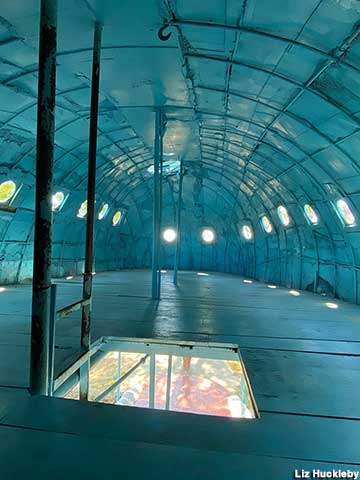
In the whale head. Tongue and teeth visible through the hatch.
Hugh died in 1990, Zelta in 2001, and the former swimming hole became an overgrown, swampy mess. The Whale's blue skin faded and peeled. But it was not forgotten. By the early 2000s local officials had expressed an interest in preserving the whale, and volunteers who Liz affectionately called "nerd highway people" -- fans of the Mother Road -- partnered with the city of Catoosa for property maintenance. "This hardcore group would come out here and spend days repainting and doing clean-up," said Liz. Hugh's solid construction (and Zelta's shotgun) had kept the whale standing long enough to be saved.
Catoosa finally purchased the 14-acre property in 2020, turning it into a city park and hiring Liz. Blue Whale Park now has picnic tables and a gift shop (where visitors can purchase turtle food for the pond's residents), and although swimming is no longer allowed, tourists don't seem to mind. "The whale makes people smile," said Liz. "Even if I come to work in a bad mood it won't last, because everyone who comes here is so happy. They'll say, 'We're seeing Route 66. This was our most important stop.'"





